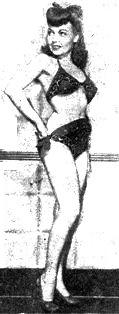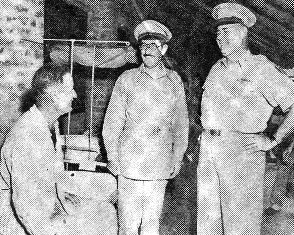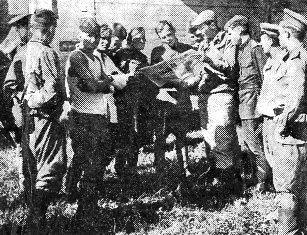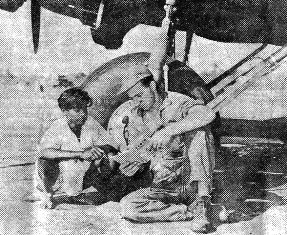
|
Japanese Need Watching Warns General Wheeler After Official Surrender
Roundup Staff Writer
SINGAPORE - "The Japanese shall have to be carefully watched in the future, for a people constituted as they are, always possess a latent sense of hostility to their conquerors."
The speaker was Lt. Gen. R. A. Wheeler, India-Burma Theater Commander and deputy to Lord Louis Mountbatten, Supreme Allied Commander in the Southeast Asia Command. He was talking to me at the government house in Singapore soon after the official surrender of the Nips in SEAC, signed that afternoon at the Municipal Building by Gen. Seishiro Itagaki on behalf of Japan and accepted by Mountbatten for the Allies.
Wheeler represented the United States at the ceremony and at the order of the Supremo received the first copy of the Jap surrender document, of which 11 copies had been stacked on the table used by the Allies.
CEREMONY IMPRESSIVE
"I think the ceremony went off very well," stated Wheeler. "It was firm, impressive, brief, in my opinion, the attitude of the Allies was that of Christian nations living up to the concepts of the things we believe, I also think the Supremo's pronouncement to the Japs before the signing was very form, leaving no doubts in'
|
AS CG'S HONOR GUARD Turner was a member of the U.S. Office of Strategic Service. Armed with a tommy gun, fatigues, and jungle boots he stood at attention for more than an hour near the conference table along with soldiers from Britain, China and New Zealand. |
The cermony had been impressive. Before a shouting crowd of thousands, Mountbatten made his way into the Municipal Building around 10:45 in the morning, as massed British and Indian troops, plus a Navy honor guard, stood at attention. He was soon followed in by Wheeler, then later by representatives of the other Allied powers.
Soon after that a seven-man Jap peace delagation, headed by Itagaki, filed into the building. A tough-looking Aussie next to me muttered some very impolite language, then turned to a British ATS girl near him and apologized. The girl smiled and said, "If I weren't of the weaker sex, I'd join you. No apology is necessary."
HOT FLOODLIGHTS
In the Nip delegation, besides Itagaki, were Lt. Gen. Numata, chief of staff to Count Terauchi; Lt. Gen. Nokimura, commander of the 18th Area Army; Lt. Gen. Kimura, CG of Burma; Lt. Gen. Kinoshito of the air force; Vice Adm. Fudodomo and Vice-Adm. Shibota. All were seemingly oblivious to the crowd and were looking straight ahead.
Inside the conference room, the hot glare of floodlights beat down on the shaven heads of the Nips, who looked like monkeys with billiard balls for heads as they stood stiffly at attention awaiting the entrance of Mountbatten. The Allied table faced the Japs at a distance of about 10 yards, and Wheeler, seated at the right of the Supremo's chair, and other Allied delegates were already presaent.
After his entrance, Mountbatten waved everyone to be seated. He then explained why the Jap Supreme Commander, Count Terauchi, was not present. He said Terauchi had wired he had been smitten with a stroke and could not attend. Mountbatten said he had sent his personal physician to verify the claim and was satisfied of its authenticity. In his communication to the Allied chief, Terauchi had delegated Itagaki as his representative. Mountbatten then asked Itagaki for his credentials.
In his statement, Mountbatten stated he wished to make it plain that this was no negotiated surrender, but that the Japs were surrendering to superior forces.
'FIRMEST MEASURES'
Upon production of Itagaki's credentials and their acceptance, the official surrender document was then signed, first by the Nip general, then by Mountbatten.
Upon completion of the 11th signature, Mountbatten waved members of the Jap delegation, none of whom had showed the slightest iota of expression, out of the hall. As they left he looked at them, slowly shook his head and passed a low-voiced comment to Wheeler.
The Supremo then went outside where the crowds were gathered around the British troops. Mountbatten's carefully modulated British accent told the troops over a field microphone that "you will have my support in taking the firmest measures against any attempt at obstinacy, impudence, or non-co-operation."
After that the troops formally passed in review. The war was officially ended in SEAC.
 If you're through drooling, we'd like to announce that the shapely gal above, clad in two strategically-placed
bandanna handkerciefs, is Mrs. Darleen DeMos, who is bidding for the title of Mrs. America. And she will not play
"drop-the-hanky."
If you're through drooling, we'd like to announce that the shapely gal above, clad in two strategically-placed
bandanna handkerciefs, is Mrs. Darleen DeMos, who is bidding for the title of Mrs. America. And she will not play
"drop-the-hanky."
|
WASHINGTON (ANS) - In the face of increased Congressional criticism of the Army's demobilization plan, the nation's military leaders took further steps this week to speed up the process of getting Servicemen out of uniform and that a predicted Army of 2,500,000 by next July might be reduced.
In special hearings of the Senate Military Committee, Maj. Gen. I. H. Edwards, assistant chief of staff, said at present three out of every four men now in the Army are assured of release by July, 1946, but that plans are underway for an even faster demobilization. This will be possible, he said, because of revised estimates of the number of men needed for occupation duty.
FURTHER REDUCTION
Edwards said that on the basis of lessened requirements by Supreme Commander Douglas MacArthur in the Pacific, it is believed that the Army's planned strength of 2,500,000 men by mid-1946 will probably be reduced.
Maj. Gen. S. G. Henry, another assistant chief of staff, told the Committe that Air and Service forces are setting up an additional 145 temporary separation centers to speed up the discharge of 253,000 eligible men. Henry also announced that 200,000 officers are already tagged for release soon, with 400,000 more due to be out of uniform by July next year.
Most members of the Committee expressed themselves as "pleased" with the Army's plans as outlined in the two day hearing. The only critical member was Edwin Johnson (D-Colo.), who proposed that the job of policing Germany and Japan be left up to Europeans, China and Russia.
AIR FORCES PLAN
Gen. H. H. Arnold, chief of the Air Forces, announced plans for completing the discharge by June, 1946, of all Air Force personnel not needed for overseas duty.
The Marine Corps also stepped up its demobilization system by reducing its critical score from 85 to 70 and authorized release of all Marines 35 years of age or older.
ONLY 200,000 MEN NEEDED
TOKYO (ANS) - The occupation of Japan is proceeding so smoothly that all the "citizen soldiers" in the Pacific probably can be demobilized within six months, leaving garrisoning of the enemy homeland to 200,000 Regular Army troops, Gen. of the Army Douglas MacArthur announced this week.
The Supreme Commander said that by using the Japanese governmental structure, he was enforcing the surrender terms with a small fraction of the millions of men, billions of dollars, and years of time that would have been necessary if the Allied military government had been established.
His formal statement said: "Within six months the occupational force - unless unseen factors arise - will probably number not more than 200,000 men. This probable size is within the framework of our projected regular establishment and will permit complete demobilization of our citizen Pacific forces which fought so nobly through to victory.
"Once Japan is disarmed, this force will be sufficiently strong to insure our will."
DOUBLE TIME
FORT DIX, N.J. (ANS) - A record total of more than 3,000 soldiers were discharged during a 24-hour period this week at the Fort Dix separation center. The total represented an increase of 100 percent over the number separated daily heretofore. The center is now working on a day and night basis.
 Theater Commander Lt. Gen. R. A. Wheeler, center, chats with Capt. Illo B. Hard, recently-liberated
American prisoner of war, during a visit to the 142nd General Hospital in Calcutta where the ex-POW's are recuperating.
Hard, member of the 131st Field Artillery Battalion (Texas), was captured on Java in March, 1942. On the right is
Brig. Gen. Robert Neyland, Base Section CG.
Theater Commander Lt. Gen. R. A. Wheeler, center, chats with Capt. Illo B. Hard, recently-liberated
American prisoner of war, during a visit to the 142nd General Hospital in Calcutta where the ex-POW's are recuperating.
Hard, member of the 131st Field Artillery Battalion (Texas), was captured on Java in March, 1942. On the right is
Brig. Gen. Robert Neyland, Base Section CG.
|
 Our boy, M/Sgt. Fred Friendly, commonly called "The Man," at Mukden, Manchuria, airfield, shows a copy of Roundup
to Soviet air force personnel. Russian woman holding the paper is a C-47 pilot. Bet "The Man" is doing the talking.
Our boy, M/Sgt. Fred Friendly, commonly called "The Man," at Mukden, Manchuria, airfield, shows a copy of Roundup
to Soviet air force personnel. Russian woman holding the paper is a C-47 pilot. Bet "The Man" is doing the talking.
|
191st Signal Repair Outfit Fighting Fungus Growth In Assam, Burma
LEDO - Out in the jungles of Assam and northern Burma is an Army Signal Repair outfit that's carrying on a continuing war against an enemy as elusive and omnipresent as the Japs ever were in this part of the world. The enemy is fungus, a spongy growth propagated by the damp, humid climate of this wild jungle land.
Fungus attacks delicate radio, telephone and teletype equipment, covers it with an acidy green mold that eats away insulations, corrodes plates and promotes rust and short circuits, and the 191st Signal Repair Company must continue to fight this enemy as long as communications must be maintained.
Since arriving in the India-Burma Theater in December last year, the 191st has been repairing and rebuilding walkie-talkies, transmitters, receivers, teletype and signal machines, switchboards, hand sets, special service radios and operating power shops to repair electrical generators.
Headquarters are at Ledo but detachments have operated at such places at Myitkyina, Bhamo, Muse and other points in northern Burma, as conditions necessitated. The outfit has a splendid record of production. During the past five months more than 2,000 individual jobs have been turned out bu the company.
One man troubleshoots the sets or equipment to determine the nature of the trouble and then makes the necessary repairs or alterations. This done, all radios and telephones are sent to the fungus treating department where a lacquer is sprayed over internal parts and the objects thoroughly baked in an oven at an extremely high temperature. This treatment resists the fungus, saves money and equipment and usually lasts through the monsoon when it is again necessary to inspect and treat the sets.
DEVISE INSTRUMENTS
After leaving the baking ovens, the work proceeds to the lineman's bench. With signal generators, he checks sets for proper tracking of frequencies. Finally two sergeants give all work a final check test before approving it.
Several men of the 191st have devised instruments and checking apparatus to speed up the work and do it more effectively. T/Sgt. J. P. Wright, of the Myitkyina detachment, developed a shortcut test set that combines several separate units in one outfit. Two men, T/4 Morton R. Kallman and T/3 Fred Fine, designed and built some special wrenches for the repair of delicate teletype equipment at Ledo.
Normally, repairs on telephone carrier systems are so difficult and require such skill that such equipment is returned to the States when faulty, but T/3 Harry Koch has been going beyond usual repairs and by his unusual ability has obviated shipping carriers back to America.
The greatest laughs the G.I.'s have had came via the Special Service sets used by soldiers One soldier brought in a set for repair and when it was opened there were only two tubes and a few stray pieces of wire inside. In another radio set that was completely sealed, they found a rat's nest and all the wires eaten up. Invariably when Chinese bring their communications equipment for repair, they always send a soldier who is unable to speak a word of English and hence cannot reveal the trouble.
MAGIC WAND
All jobs confronting them have not been strictly G.I., but the boys have come through anyway. At a radio show in Myitkyina, it was found that the Indian ponies were a bit sluggish, but this was soon solved by an electrical tickler rigged up by the 191st men. A slight prod with the magic wand made the lethargic steeds charge with the spirit of a wild Mexican pony.
Not long ago they were testing a PA system when one of the men began "mooing" over the mike. Soon, the building was surrounded by admiring groups of cows who had heard the call of the wild.
Cpl. John S. Clarke, projector repairman at Myitkyina, had acted as one of the movie operators when the outfit first arrived in this northern Burma town shortly after it had fallen to our forces. After numerous trips back and forth to the movie area, Clarke discovered a fence around the lot where he had been walking and signs displaying the warning: "Keep out, Unexploded Duds."
EDUCATIONAL PROGRAM POPULAR IN THEATER
"Education? No, I don't want to go back to school when I get home. I want to go to work and make lots of money like the war workers have... $150 a week. No kid schooling for me. I haven't got the time."
That and similar answers are typical of many that this writer received in a brief trip through India and Burma over the past few days. But in what seemed just as many cases, replies were just the reverse. Men of all ages in the Army - from 20 years old up into the 30's - are anxious to improve their future by further training when they are discharged.
This informal survey was undertaken to see just what interest is being shown in the educational opportunities being
 A C-46 line mechanic, Sgt. Paul Schleuter, San Francisco, takes time out during a break to catch up on his radio course as an Indian laborer looks on.
A C-46 line mechanic, Sgt. Paul Schleuter, San Francisco, takes time out during a break to catch up on his radio course as an Indian laborer looks on.
|
But interest in study throughout the Theater is startling, even though the men know that they are going home and may not be able to finish courses here. From deep in the jungles of northern Burma to the shifting sands of the Sind Desert men are burning the midnight oil.
Lt. Ralph L. Gwodney, of Detroit, is in charge of "Comcar College," the 3rd Combat Cargo Group school at Myitkyina. More tha n 200 men are enrolled, taking all kinds of high school and college subjects. Like other schools organized by Information and Education officers and EM. Comcar uses textbooks and materials supplied by the U.S. Armed Forces Institute. Qualified instructors are selected from the local units and paid for their efforts. Full credit is granted to the student upon completion of a course, enabling him go get ahead in his educational program when he gets home. Even if he doesn't finish here, he can when he gets home. No man's trip home will be delayed by these courses.
"The University of Malum" has closed its doors on the south airstrip at Myitkyina, since so many men have left that it was impractical to continue. However, Lt. John Woolf, Providence, R.I., of the 18th General Hospital, is at present on a trip down the Stilwell Road. He is driving a jeep equipped with a loudspeaker outfit that broadcasts a series of recordings explaining the G.I. Bill of Rights to all the units he meets.
A sad sight is Pentagon University at Myitkyina. It has suffered the same fate as Malum U and now the building stands empty, its functions completed.
FOXHOLE U.
In Ledo, one of the most impressive education units has been developed by the perseverance of Sgt. William Lederer, aided by Capt. Guy Smith, I & E Officer for Advance Section. It is Foxhole University, with a regular campus of basha classrooms and a curriculum of 24 subjects. An enrollment of 350 men is under 27 instructors. Three men besides Lederer, Cpl. Martin O'Kean of Trenton, N.J.; Pvt. Tony Lucero of Sanat Fe, N. Mex.; and Pvt. Robert Richards, Negro instructor of Cleveland, O., are working full time at Foxhole U.
This writer had a ride in a jeep built from salvaged parts by the students of the auto mechanics class, sat in on a class for radio technique given by Jerry Sears of AFRS station VU2ZN, and saw lights burning in the photography lab after midnight.
At Chabua, the "North Assam Arts and Business Institute," with Cpl. Sol J. Bernstein of Butler, Pa., as dean, carries on. Capt. Don Torry, the I & E Officer for Intermediate Section is the "President." A large warehouse has been completely renovated and inside neat, well-equipped classrooms house 100 students. Probably the most unique class is that in contract bridge taught by M/Sgt. John Conrad of St. Louis. Army Nurse Lt. Violet Kensington of the 234th General Hospital is among the students studying the Culbertson system.
URGES SERIOUSNESS
Cpl. Bernstein made one point that makes sense. He warned that "men studying in the Army or going back to school as civilians just for something to do or as a soft touch are just wasting their time and that of the school." He urged a completely serious attitude toward any study.
Also in the Chabua area, Capt. Christopher Dariottis at the Northern Air Service Command, Lt. David Brown at the Assam Air Depot, W/O J. J. Haas at the Intermediate General Depot, Lt. Albert Lewis at the 1332 AAF Base Unit, Lt. Roth E. Hook at the 51st Service Group, and Lt. Frank Surovick at the 199th Ordnance Battalion are also directing group study programs.
Renshaw University, named for Col. Harry Renshaw, the Commanding Officer of the 1333 AAF Base Unit, killed in an accident recently, has been operating since February at that base. Capt. Harold Wise and Cpl. James M. Senor are proudly watching the progress of their school. Ten teachers instruct 150 airmen in studies of all kinds.
MARRIAGE STUDY
Subjects like "So You Want to Get Married?," "The Returning Husband," and "Birth Control" are listed in a special marriage seminar at Renshaw. Capt. Albert H. Towbridge, professor of zoology at the University of Oklahoma, and Capt. Henry G. Graham, psychiatrist at the 234th General Hospital, are lecturing.
Bamboo University is the center for scholars of the 1326 AAF Base Unit at Lalmanir Hat. Two hundred men study there regularly.
At Agra, it's the University of Agra under the joint auspicies of Lt. Vincent Schuman and S/Sgt. Nat Horowitz. A well-rounded group of studies attract men in various fields.
In the Calcutta area, Lt. Adolph K. Berge has organized the Tolly School at Camp Tollygunge with about 100 men studying high school and college subjects. Teke-Hai College is the center for G.I. students of the 1305 AAF Base Unit at Dum Dum Airport. They are attending various courses in considerable numbers.
Col. R. W. Mayer, I & E Officer for the AAF of the I-B Theater, working quietly behind the scenes, has been instrumental in pushing the education program. His activities in directing studies for illiterates have been outstanding.
The Commandant of the U.S. Armed Forces Institute, CBI Branch, Maj. E. F. Gerold, Jr., has put many months of effort into promoting the expansion of his program, USAFI, the backbone of the whole G.I. study system is serving India, Burma and China through its Calcutta office. Capt. George P. Wild, recorder, and Lt. Louis J. Gowat, consultant, are members of the staff.
I-B Theater education is under the direction of Capt. Walter T. Pulsifer, whose office is part of the Information and Education Section of Theater Headquarters.
The Roundup is a weekly newspaper of the United States Forces, published by and for the men in Burma and India, from news and pictures supplied by staff members, soldier correspondents, Army News Service and United Press. The Roundup is published Thursday of each week and is printed by The Statesman in New Delhi and Calcutta, India. Editorial matter should be sent directly to Major Floyd Walter, Hq., U.S.F., I.B.T., APO 885, New York, N.Y., and should arrive not later than Saturday in order to be included in that week's issue. Pictures must arrive by Friday and must be negatives or enlargements. Stories should contain full name and organization of sender. Complaints about circulation should be sent directly to Capt. Drexel Nixon, Base Section APO 465, New York, N.Y. Units on the mailing list should make notification of any major change in personnel strength or any change of APO.

SEPTEMBER 20, 1945
Original issue of IBT Roundup shared by Virginia Dyer, widow of CBI veteran Stanley Dyer.
Copyright © 2006 Carl Warren Weidenburner
TOP OF PAGE PRINT THIS PAGE ABOUT THIS PAGE SEND COMMENTS
PREVIOUS ISSUE CLOSE THIS WINDOW NEXT ISSUE